 Maxim Khabur
Maxim Khabur How to choose the right Forklift Battery
16600 Aston
Irvine, CA 92606
http://onecharge.biz/
Choosing industrial batteries can be complicated—there are just so many options that it can be difficult to decide which factors are most important: Ah capacity, chemistry, charging speed, cycle life, brand, price, etc.
If you already know what to expect of your battery, use the forklift battery selector to see available options.
If you’d like to learn which requirements of your material handling operations are crucial for choosing the right forklift battery, read on.
1. Start with the make and model of your forklifts and lift truck specs
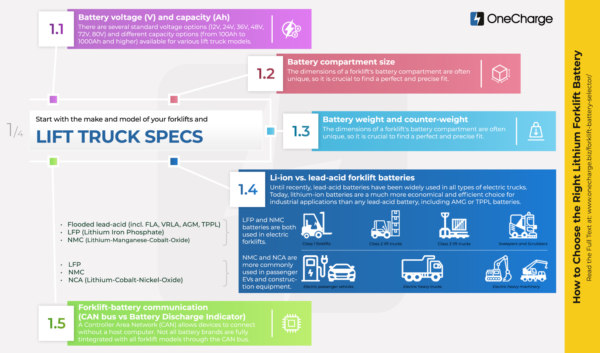
Your choice of power source for the equipment is defined primarily by the forklift’s technical specifications. As the users of diesel- or propane-powered Class 4 and 5 sit-down forklifts continue to convert to Class 1 electric, more than half of lift trucks today are battery-powered. Durable, high-capacity Li-ion batteries have become available for even the most demanding applications handling heavy and bulky loads like steel, lumber, paper, and beverages.
The following are the main specs you need to look at.
1.1 Battery voltage (V) and capacity (Ah)
There are several standard voltage options (12V, 24V, 36V, 48V, 72V, 80V) and different capacity options (from 100Ah to 1000Ah and higher) available for various lift truck models.
For example, a 24V 210Ah battery is typically used in 4,000-pound pallet jacks, and 80V 1050Ah would fit a counterbalanced sit-down forklift to handle loads up to 20K pounds.
1.2 Battery compartment size
The dimensions of a forklift’s battery compartment are often unique, so it is crucial to find a perfect and precise fit. It is also important to consider the cable connector type and its location on the battery and a truck.
Some OEM manufacturers (e.g. Combilift, AisleMaster) have two battery compartments of different sizes. The CUSTOM Series lithium battery is a good example of how a battery is engineered to meet certain equipment’s unique specs.
1.3 Battery weight and counterweight
Different forklift models have different recommended battery weight requirements that you should consider while making your choice. An additional counterweight is added to a battery intended for use in applications with heavy loads.
1.4 Li-ion vs. lead-acid forklift batteries in different types of electric forklifts (Classes I, II, and III)
Lithium batteries are best suited for Class I, II, and III forklifts and other off-road electric vehicles, like sweepers and scrubbers, tugs, golf carts, etc. The reasons? Triple the lifespan of lead-acid technology, excellent safety, minimal maintenance, stable operation at low or high temperatures, and high energy capacity in kWh.
LFP (Lithium Iron Phosphate) and NMC (Lithium-Manganese-Cobalt-Oxide) batteries are both used in electric forklifts. The recent tests of lithium battery types at Sandia Laboratories show that LFP batteries will actually last longer and are more reliable than NMC.
NMC and NCA (Lithium-Cobalt-Nickel-Oxide) types of lithium batteries are more commonly used in passenger EVs and electronics due to their lower overall weight and higher energy density per kilogram. NMC industrial batteries are used by some OEM manufacturers (Kalmar, for example) in construction equipment like cranes and excavators.
Until recently, lead-acid batteries have been widely used in all types of electric forklift trucks. TPPL is the newer version of such batteries. It has higher efficiency and higher charging speed but only compared to traditional flooded lead-acid technology or sealed lead-acid batteries, like absorbent glass mat (AGM).
In most cases, lithium-ion batteries are a much more economical and efficient choice for industrial applications than any lead-acid battery, including AGM or TPPL batteries.
1.5 Forklift-battery communication
A Controller Area Network (CAN bus) allows microcontrollers and devices to communicate with each other’s applications without a host computer. Not all battery brands are fully integrated with all forklift models through the CAN bus. Then there is the option of using an external Battery Discharge Indicator (BDI), which provides the operator with visual and audio signals of the battery’s state of charge and readiness to work.
At OneCharge, we make both options and are ready to develop CAN options with any lift truck make and model.
2. Factor in the details of your material handling equipment application and your company policies
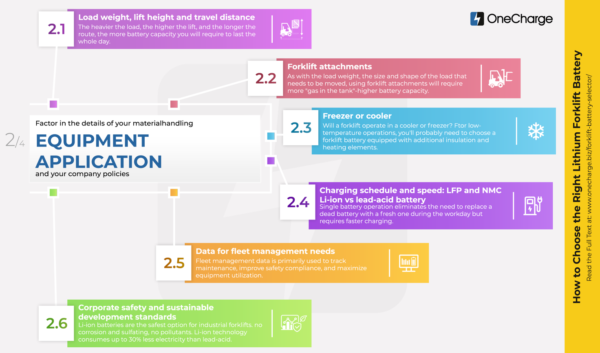
The battery’s performance must fit the actual use of the forklift or lift truck. Sometimes the same trucks are used in different ways (handling different loads, for example) in the same facility. In this case, you may need different batteries for them. Your corporate policies and standards may also be in play.
2.1 Load weight, lift height, and travel distance
The heavier the load, the higher the lift, and the longer the route, the more battery capacity you will require to last the whole day. Take into consideration the average and maximum weight of the load, travel distance, height of the lift, and ramps. The most demanding applications, such as paper and packaging or food and beverage, where load weight can reach 15–20 thousand pounds, will require an 80V POWER Series lithium battery with up to 1050Ah capacity.
2.2 Forklift attachments
As with the load weight, the size of the pallet, or the shape of the load that needs to be moved, using heavy forklift attachments will require more “gas in the tank”—higher battery capacity. A hydraulic paper clamp is a good example of an attachment for which you need to plan some extra power.
2.3 Freezer or cooler
Will a forklift operate in a cooler or freezer? For low-temperature operations, you’ll probably need to choose a forklift battery equipped with additional insulation and heating elements, like the FROST Series lithium battery.
2.4 Charging schedule and speed: LFP and NMC Li-ion vs lead-acid battery
Single battery operation eliminates the need to replace a dead battery with a fresh one during the workday. In most cases, this is only possible with the opportunity charging of a Li-ion battery during breaks, when it is convenient for the operator and does not disrupt the production process. Several 15-minute breaks during the day are enough to keep the lithium battery at over 40% charge. This is a recommended charging mode that provides top performance for a forklift and helps to extend the useful life of the battery.
Read the full text of How to Choose the Right Lithium Forklift Battery.
2.5 Data for fleet management needs
Fleet management data is primarily used to track maintenance, improve safety compliance, and maximize equipment utilization. Battery management system (BMS) data can significantly enrich or replace data from other sources with detailed info on power consumption, the timing of charging and idle events, battery technical parameters, etc.
Easy data access and the user interface are becoming the most important factors when choosing a battery.
2.6 Corporate safety and sustainable development standards
Li-ion batteries are the safest option for industrial forklifts. They don’t have any of the issues of lead-acid technology, such as corrosion and sulfating, and do not emit any pollutants. They eliminate the risk of accidents associated with the daily replacement of heavy batteries. This benefit is crucial in industries such as food and beverage, medical supplies, electronics, etc. With Li-ion electric forklift batteries, you do not need a specially ventilated room for charging.
Read the full text of How to Choose the Right Lithium Forklift Battery.
3. Evaluate the battery price and future maintenance costs
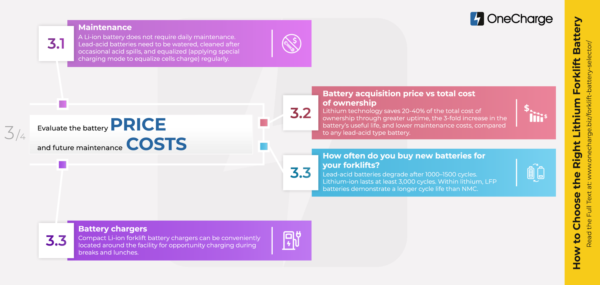
3.1 Maintenance
A Li-ion battery does not require daily maintenance. Lead-acid batteries need to be watered, cleaned after occasional acid spills, and equalized (applying special charging mode to equalize cells charge) regularly. Labor and external service costs tend to increase as the lead-acid power units age, resulting in decreasing uptime and contributing to constantly increasing operational costs.
Read the full text of How to Choose the Right Lithium Forklift Battery.
3.2 Battery acquisition price vs total cost of ownership
The purchase price of a lead-acid power unit plus charger is lower than a lithium package. However, when switching to lithium you need to take into account the increase in uptime provided by single battery operation and the flexible opportunity charging schedule, the 3-fold increase in the battery’s useful life, and lower maintenance costs.
Calculations clearly demonstrate that a lithium-ion battery saves up to 40% in 2–4 years on the total cost of ownership compared to a lead-acid battery.
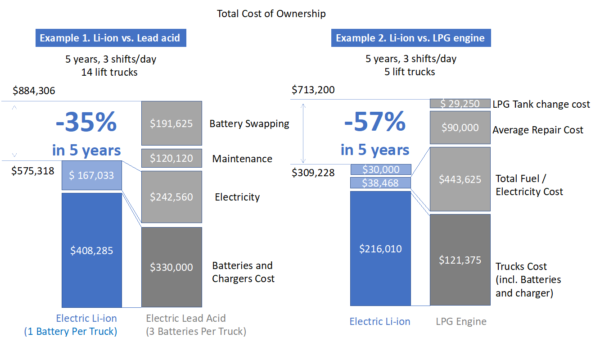
Among lithium batteries, the LFP lithium battery type is a more economical and efficient choice than NMC lithium batteries.
In most cases, it makes economic sense to switch to Li-ion, even if you operate a small fleet or a single forklift.
3.3 How often do you buy new batteries for your forklifts?
Lithium batteries have a longer lifespan than any lead-acid power pack. Lead-acid batteries lifespan is 1000–1500 cycles or less. Lithium-ion lasts at least 3,000 plus cycles depending on the application.
TPPL lead-acid batteries have a longer lifespan than conventional liquid-filled or sealed AGM batteries, but they can’t even come close to a lithium-ion technology in this aspect.
Within lithium, LFP batteries demonstrate a longer cycle life than NMC.
3.4 Battery chargers
Compact Li-ion forklift battery chargers can be conveniently located around the facility for opportunity charging during breaks and lunches.
Lead-acid batteries require massive charging stations and need to be charged in a ventilated charging room to avoid risks of contamination associated with acid spills and fumes during charging. Eliminating a dedicated battery room and bringing back this space to profitable use usually make a big difference for the bottom line.
Read the full text of How to Choose the Right Lithium Forklift Battery.
4. How to choose a battery with a focus on brand and vendor
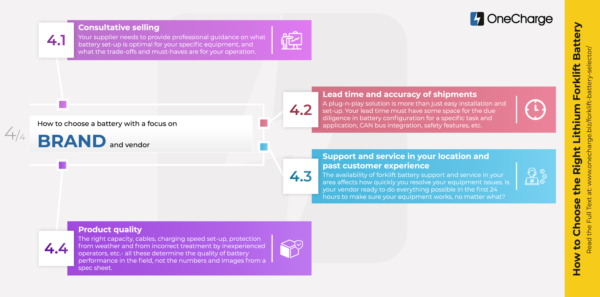
4.1 Consultative selling
Selecting and procuring the right battery can take a lot of effort and time. Your supplier will need to provide professional information on what battery set-up is optimal, and what the trade-offs and must-haves are for your specific equipment and operation.
4.2 Lead time and accuracy of shipments
A plug-n-play solution is more than just easy installation and set-up. It includes due diligence in battery configuration for a specific task and application, connection protocols like CAN bus integration, safety features, etc.
So, on the one hand, you’d want to have the batteries delivered just in time when your new or existing forklifts are ready to start. On the other hand, if you choose just what is available and rush the order, you may discover that a lift truck or your material handling operations are incompatible with the batteries.
4.3 Support and service in your location and past customer experience
The availability of forklift battery support and service in your area affects how quickly you resolve your equipment issues.
Is your vendor ready to do everything possible in the first 24 hours to make sure your equipment works, no matter what? Ask former customers and OEM dealers for their recommendations and past experience with the battery brand you plan to purchase.
4.4 Product quality
Product quality is mainly defined by how closely a battery can meet the requirements of operations. The right capacity, cables, charging speed set-up, protection from weather and from incorrect treatment by inexperienced forklift operators, etc.— all these determine the quality of battery performance in the field, not the numbers and images from a spec sheet.
About the Author:
Maxim Khabur is the Marketing Director of OneCharge, Inc., based in Irvine, CA.









